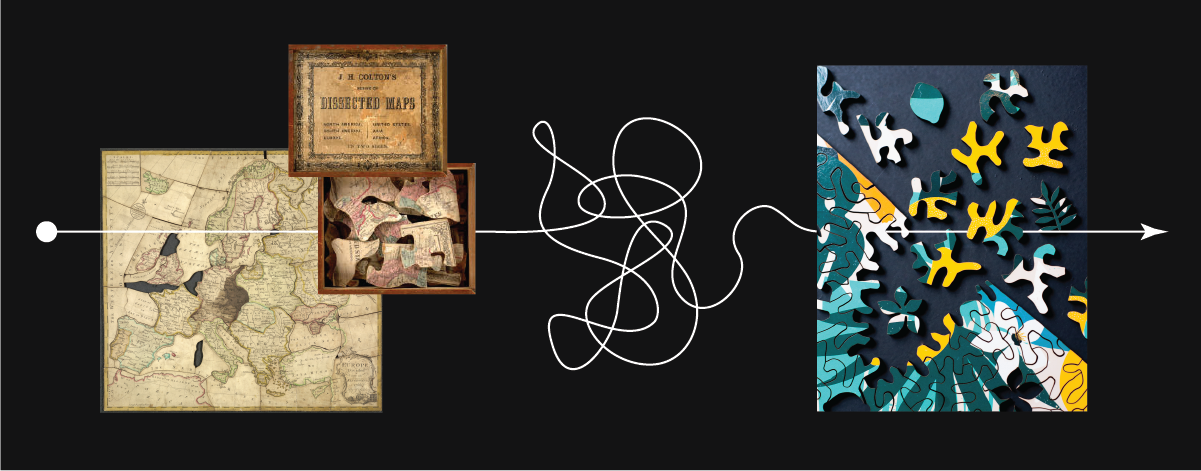
The Surprising History of Jigsaw Puzzles
Here’s a history lesson they never covered in high school!
Jigsaw puzzles have truly been with us humans through thick and thin. Wars, depressions, pandemics. They’ve gotten us through—and continue to get us through—a lot.
As you may have heard, jigsaw puzzles are seeing a major boom right now, thanks to people spending more time at home looking for stimulating, relaxing activities. We’re all trying to keep our spirits high and disconnect (preferably screen-free), so jigsaw puzzles are a great option.
But how did jigsaw puzzles become a thing? Why do we even call them jigsaw puzzles?
It all starts back in 1762.
The Puzzle OG
A British map engraver named John Spilsbury is said to be the inventor of jigsaw puzzles, though they didn’t have the name jigsaw back then. He first created what he called a “dissected map” puzzle in 1762 by mounting one of his maps onto wood and then cutting around the countries with a scroll saw.

The goal? To help children learn geography! Each country or continent was roughly a different piece and it caught on fast.
Soon, others were copying his process and expanding the images to cover other areas. People started creating puzzles that portrayed things like farm imagery, religious scenes, nursery rhymes, fairy tales, ship and train designs.
You know, all the important 1700s subjects.
1880s: The Jigsaw Puzzle Boom
This style of puzzle was known as dissected puzzles for quite a while until, in the 1880s, a new tool was developed called—wait for it!
The jigsaw.
The jigsaw let puzzle developers increase their speed and accuracy until it eventually became the primary method for puzzle development. It was also during the 1880s that puzzles started to get really popular with adults, not just kids.
Lithographic printing techniques became much more sophisticated, allowing wood to adhere to high quality prints with finer details and brighter, clearer colours. Some puzzle makers started using plywood instead of hardwood, which was easier to cut into intricate shapes and was more affordable.
Eventually, the tredle jigsaw was invented, which allowed for even more intricate shapes and faster production. That meant even trickier puzzles could be made!
Producers started developing all sorts of different types of piece shapes too. There were crazy straight edges in the middle of puzzles and themed whimsy shapes, to name a few. Whimsy shapes are pieces designed with the theme of the puzzle in mind. For example, a tree puzzle might have a leaf-shaped piece or a map puzzle might have a piece shaped like a mini version of a country.
Fun fact: Several of our own puzzles at Puzzle Lab feature cool whimsy shapes!
Jigsaw Puzzles: The Ultimate Advertising Tool?
In the 1920s and 1930s, many companies started using jigsaw tools to promote their products and services. For instance, in the 1920s, Great Western Railway made a puzzle of their steam engine to advertise their railways and the destinations they frequented.

Then there was Cunard Cruises, who started to make postcard-sized puzzles that they sold on their cruise liners as souvenirs. These puzzles were sold in boxes with images of the finished product on them which was a first! Before then, puzzlers would have considered it cheating to see the finished image before beginning. Can you imagine?
Jigsaw Puzzles, the Great Depression, and WW2
It was during the Great Depression of the 1930s that jigsaw puzzles really took off.
Puzzles were a way for people to enjoy fun, stimulating activities without spending a lot of money. They gave them a sense of accomplishment when the outside world seemed increasingly out of their control (sound familiar?).
Basically, puzzles gave families a way to spend time with each other, distract themselves from the daily hardships, and enjoy a little soothing problem solving.
Anne Williams, a jigsaw puzzle historian and author of "The Jigsaw Puzzle: Piecing Together a History," told CBS News that 30 millions households in the USA were absorbing 10 million puzzles a week during the Great Depression.
Wow.

By the time 1939 and the onslaught of World War 2 rolled around, puzzle makers started to shift away from wooden puzzles and use cardboard instead because plywood plummeted in supply. The cardboard was very poor quality, but at least it allowed more people to enjoy puzzles during those especially hard times.
Puzzles and the 21st Century
Today, puzzle makers leverage some serious technology and design to create gorgeous puzzles. Here at Puzzle Lab, we start by curating stunning graphics (many that are licensed from talented Canadian artists). Then we head to our digital laboratory and use custom computer algorithms to design the pieces before they’re cut out of eco-conscious wood with lasers.
Yeah, from rickety saws and plywood pictures of maps, to algorithm-designed, laser-cut artistic masterpieces...We’ve come a long way.
There are also huge communities of passionate puzzlers: just do a search on Instagram, TikTok, or YouTube and you’ll find puzzlers showing off impressive skills, reviews, and stories about the joy of puzzling.
And, of course, with COVID-19 upon us these days, times are once again extra tricky and unexpected. So people are turning towards puzzles in pursuit of something that feeds the soul, challenges the mind, and satisfies our collective craving to solve some of the puzzles in our lives.
We’re so grateful to be a part of that!
If you’re in the market for a gorgeous new puzzle, check out our shop. We’re frequently updating it with new masterpieces and we even offer custom creations if you want to turn your own one-of-a-kind photo into a gorgeous wood jigsaw puzzle.


